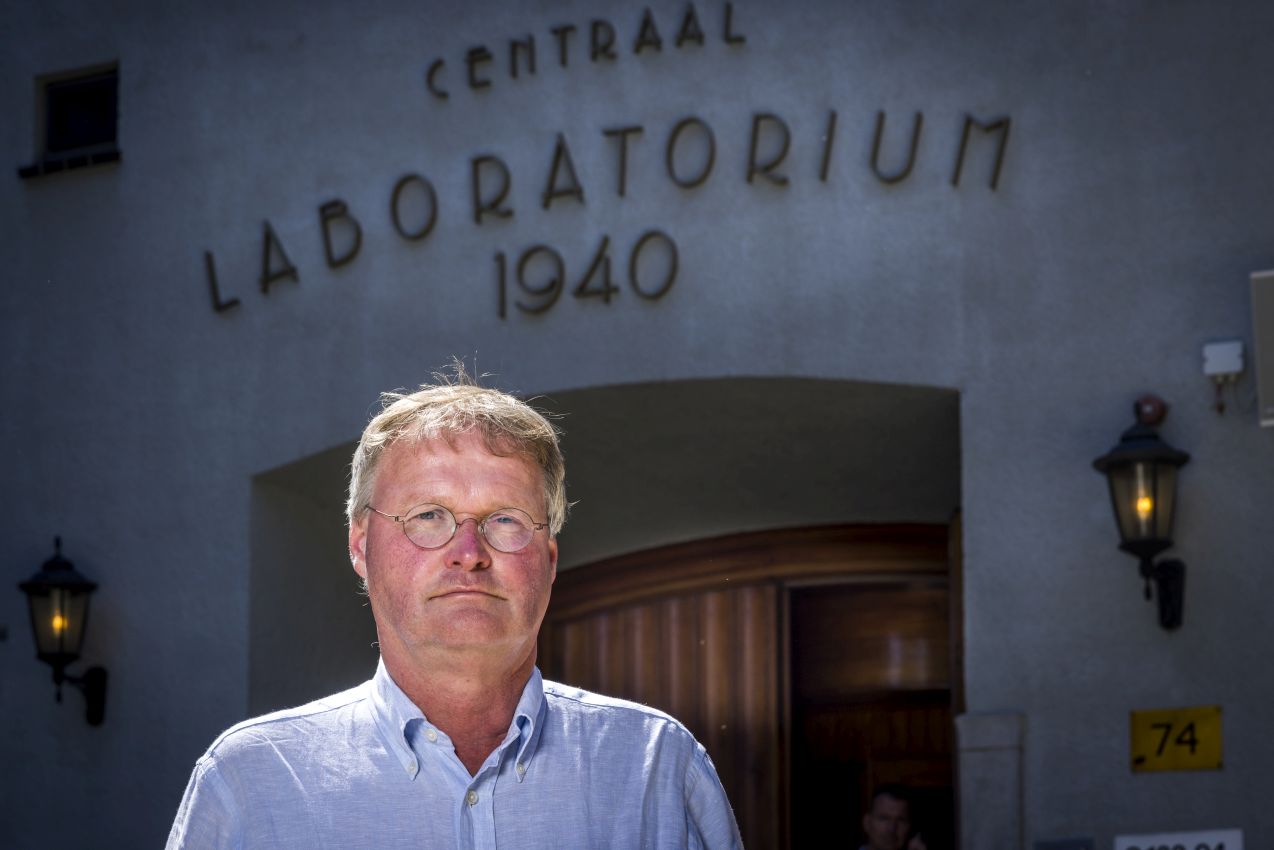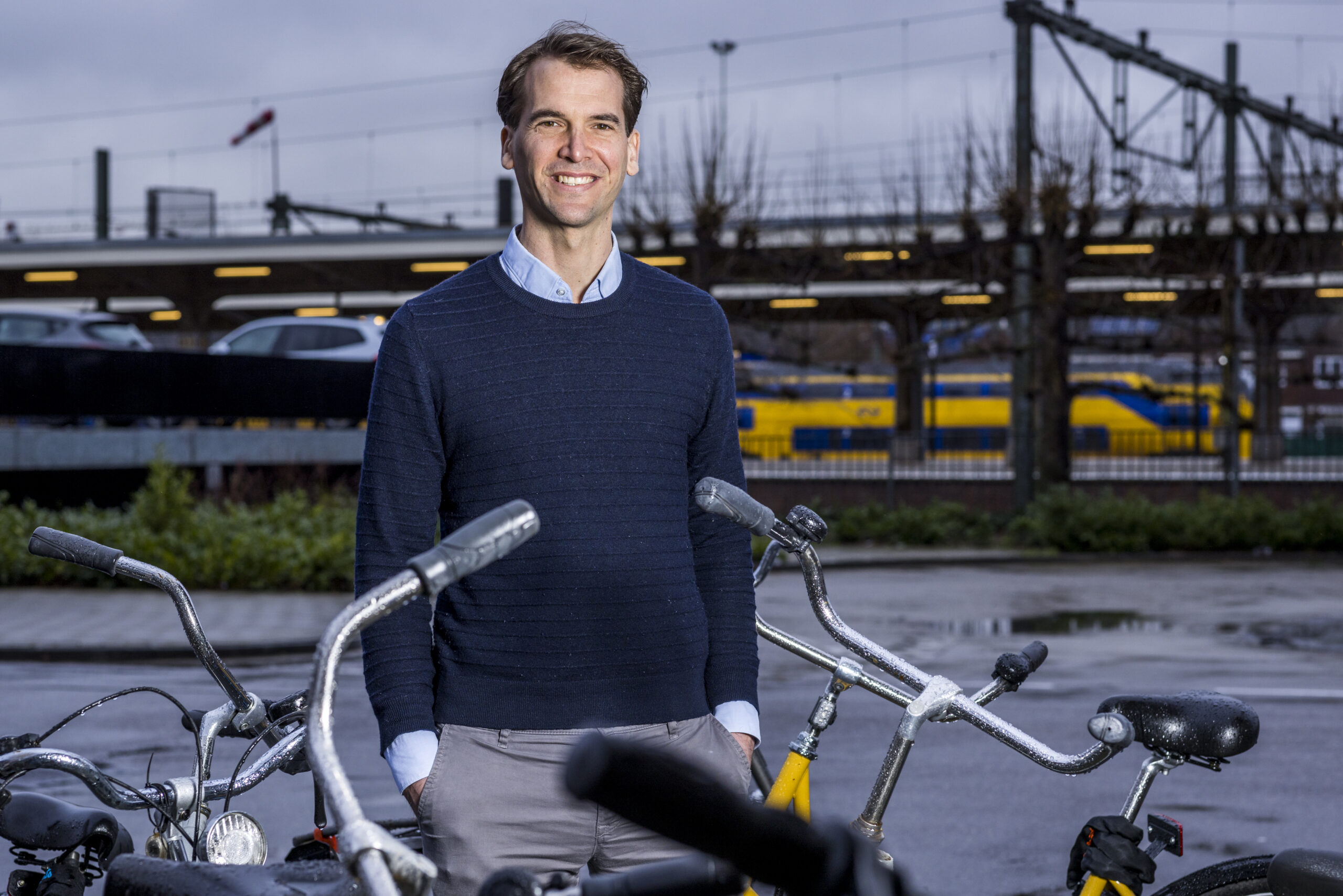
Professor Gerard Bos and his company CiMaas are developing a vaccine as well as killer cells to fight cancer in their lab. The knowledge is there; it’s just a matter and time and particularly money at this point. The first leukemia patients could be able to receive treatment by early 2023.
An artist’s impression of killer cells attacking cancer cells hangs in his office at Brightlands Chemelot Campus in Geleen. They look like spheres in an ice cream sundae, where the pistachio flavor is attacking the hazelnut. This is naturally a simplified representation of what Professor of Internal Medicine Gerard Bos and his team work on in the lab at the Brightlands campus in Geleen. In this lab, they reproduce and improve killer cells and are developing a vaccine against cancers such as leukemia.
Coincidence
Becoming a grocer like his father was not what he wanted to do when he grew up. His mother, who ran the store with his father, thought he should study medicine. After talking to the family doctor, he took his mother’s advice. An advertisement he saw in the local newspaper drew his attention to the new faculty at the university in Maastricht. Coincidentally, his visit as a student to a conference on receptors came to his later supervisor’s attention, eventually leading to a bone marrow transplantation study in leukemia patients. Born in Wageningen, Gerard Bos has a message: life consists of pure coincidence.
One thing we have certainly done well is to stand firm. We have two products in the pipeline; killer cells and the vaccine.
Soccer
After spending time in the Randstad and Brussels, he and his wife, a pediatrician, settled permanently in Maastricht in 2000. He had passed up the chance to do research in Seattle. “Would I still make the same decision? I don’t know. This city offers a good quality of life. My children were able to play soccer in their backyard for 15 years, something they never could have done if we had lived in the Randstad.”
It might just be a layman’s idea, but one would hope that vaccines and killer cells are being diligently studied all over the world. Gerard Bos: “If you want me to be depressed, then yes, you should start talking about these studies and ask whether we are still on schedule or if our work is unique. One thing we have certainly done well is to stand firm. We have two products in the pipeline; killer cells and the vaccine. Do they still have potential? Yes. Are there lots of competitors who can do the same thing? Definitely, given the size of the facilities here, I think the chances of success of getting products from the lab to the patient are a bit lower than in other parts of the world. This would have definitely been a bigger success in Seattle since the infrastructure there is larger.”
Bos still praises the freedoms he has in Limburg. “I started here with an empty laboratory and a catalog explaining how to order a pipette tip. I taught the first analyst how to grow cells. This person ultimately got their Ph.D. under my supervision, so it was a bottom-up situation. And freedom is great.”

Life sciences
CiMaas got its start at Brightlands Maastricht Health Campus. “Jan Cobbenhagen and his team do a great job facilitating our work. They were the ones who arranged for me, as a doctor – together with my colleague Germeraad – to start a company (CiMaas) through the Kennisregeling (Knowledge Regulation). We teamed up with Neuroplast to set up a lab at Brightlands Chemelot Campus in Geleen. They also produce a cell therapy product, enabling us to share the costs and benefit from each other in other ways.”
All of the cancer research has naturally also yielded many advantages. “When I started studying, there were certain diseases for which patients’ life expectancy was only two and a half years; this is now ten. Cell therapy methods ensure a chance of recovery from certain lymph node cancers. There is an evolution in this sense, and it’s moving fast. This is partly due to researchers like us, start-ups, and the pharmaceutical industry that is permanently scouting new products. What’s happening, and where’s it happening? Countries like America and China are in the lead. I was at a conference in Boston a few weeks ago that focused on cell therapy for Kahler’s disease, mainly to see if there’s room for our research and products. The conclusion was that we should choose a different disease, so that’s why we’re mostly concentrating on leukemia and breast cancer.”
If someone says, ‘Hey, here’s an extra two million,’ we could be treating leukemia patients with killer cells by early next year.
Benefactor
Time and money are Bos’ main concerns. “We can definitely make an impact, and fortunately for patients, we are taking steps in this direction. We might be one of these steps.” This research might never have gotten off the ground without the wealthy, now deceased Heerlen real estate broker Henk Stienstra. “We owe our existence to him alone. I wrote him a letter when I saw he had made the Quote 500 list. After three phone calls, he finally agreed to meet with me. He asked why I wanted to see him. I said, ‘To raise money.’ His response: ‘That’s a shame because I just gave a few friends ten million last week for research in Amsterdam.’ Within half an hour, I left with a commitment of 500,000 guilders. That was the start of our research and a lasting friendship. This was also when we laid the foundation for the Limburg Cancer Research Fund because I thought that we had to be responsible for finding that money locally in this area. We could ask the KWF Kankerbestrijding (Dutch Cancer Society) for funding, but we still have to invest energy in it. And while we did find a benefactor, you still need around 20 of them here in Limburg because many young people are doing good research.”
Eradicating cancer
Gerard Bos and his team at CiMaas are constantly looking for new challenges. And sometimes they find them, such as the loan of around two million Euros from the Netherlands Enterprise Agency. A grant of 1.5 million Euros was also recently awarded to Maastricht University, Utrecht University, and CiMaas for research on killer cells and breast cancer. Sometimes things don’t go as expected. “We spent a great deal of time in recent years with a listed partner in America that was planning to make ten million Euros available for our joint research. Everything was more or less settled, and when it came time to sign, we discovered that the CEO and Board had parted ways. Back to the drawing board.”
“It’s not like we’re broke,” says Gerard Bos. “We’re working hard and are very hopeful. Of course, the entire team and I believe that it will work out otherwise, I would just quit. It’s also possible that tomorrow someone will suddenly announce that they’ve found something after all. Three Nobel Prizes and cancer is eradicated. There’s always the risk that someone else will get there faster. We would, of course, prefer to be the ones announcing the good news.”
Should all 87-year-old men be treated for their prostate cancer? This is a pretty philosophical question. Our firm commitment to breast cancer, for example, is apparent when you see that women, in particular, can be affected by it at a relatively young age.
Couple million
CiMaas is right on track, in Bos’ view. “We’ve been working on killer cells for years, we built this lab, we have a permit from the inspectorate to produce a vaccine, and if someone says, ‘Hey, here’s an extra two million,’ we could be treating leukemia patients with killer cells by early next year. We had almost achieved this with that American partner. We will find that two million, even without them.”
Making killer cells is a particularly complicated process. “Not only do you have to make these cells, but the cancer cells have to respond to them, which is always a risk. Killer cells are capable of distinguishing between diseased and healthy cells. Five percent of our white blood cells are killer cells, and they’re called that because they’re part of your first line of defense if you get COVID or another viral infection, for example. Our bodies produce more of these cells which attack infected cells.”
Shouldn’t more money be freed up for research?
“There are also people who say, what are so you worried about? Most people live to be 75 without cancer. Shouldn’t we be spending our money on nice things? Cancer’s a first-world problem, right? Except for children, they almost always get acute leukemia and recover 80% of the time. Should all 87-year-old men be treated for their prostate cancer? This is a pretty philosophical question. Our firm commitment to breast cancer, for example, is apparent when you see that women, in particular, can be affected by it at a relatively young age. This means a lot of investment is necessary, but money is a scarce commodity in our society; we need to be aware of this and treat it with care.”
Not a lifestyle disease
You could also invest more in a healthier lifestyle, but Gerard Bos has very explicit thoughts about this. “Cancer isn’t a lifestyle disease. Cancer is a process of aging. When you start looking at chromosomes and proteins in cancer cells, you can see that the cell’s self-repair mechanism is gone. A cancer cell usually doesn’t divide quickly but loses its ability to die. Even though the damaged cell divides slowly, there will still be many of them after a few years. And when our bodies contain more than a kilo of malignant cells, it becomes hard on them. Sometimes your immune system is compromised, which can contribute to the development of cancer, but for 80 or 90% of people, the main factor is the aging process.”

Engineerable
Bos had another interesting comment. If we all start eating healthy, we will get more cancer. “What happens if we all start eating healthy? It means you probably won’t die of cardiovascular disease, or if you do, it will be at a much later age. Lifestyle has more of an effect on cardiovascular disease than cancer, with smoking being the exception! As a result, you’ll live longer, which means you will be more likely to get cancer. If more people live to a ripe old age, we will have more older adults and many more cancers. It’s similar to the fact that more older women get dementia because the men didn’t live to the same age. Politicians don’t understand it either; dying from cancer is much more expensive than dying from cardiovascular disease. In the medium term, prevention focused on lifestyle is not cost-effective for healthcare. But you do live longer, and that’s a win.”
“Sometimes it’s accurate,” he says, putting things in perspective. “If you drink alcohol, for example, as a woman, you are slightly more likely to get breast cancer. But there is a world of experts out there who, in my opinion, take too stark a view in interpreting the facts. They suggest that healthy living can make the world engineerable, and cancer can be prevented. Considering all of this, fighting cancer remains an intellectual challenge, but I still prefer it to being a grocer.”

